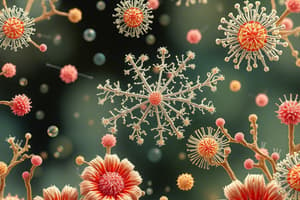Podcast
Questions and Answers
Which of the following is NOT a characteristic of prokaryotic cells?
Which of the following is NOT a characteristic of prokaryotic cells?
- Have a cell wall
- Lack a membrane-bound nucleus
- Contain ribosomes
- Possess membrane-bound organelles (correct)
What is the primary mode of reproduction for most microbes?
What is the primary mode of reproduction for most microbes?
- Budding
- Parthenogenesis
- Asexual reproduction (correct)
- Sexual reproduction
Which of the following is an example of a microbe that can survive in extreme environments?
Which of the following is an example of a microbe that can survive in extreme environments?
- Archaea (correct)
- Yeast
- Salmonella
- E. coli
What is the primary role of microbes in nutrient cycling?
What is the primary role of microbes in nutrient cycling?
Which of the following is NOT a characteristic of viruses?
Which of the following is NOT a characteristic of viruses?
How do microbes contribute to soil fertility?
How do microbes contribute to soil fertility?
What is the term for the process by which some microbes obtain energy from chemical reactions with inorganic substances?
What is the term for the process by which some microbes obtain energy from chemical reactions with inorganic substances?
Which of the following best describes the size range of microorganisms?
Which of the following best describes the size range of microorganisms?
Flashcards
Microorganisms
Microorganisms
Microscopic organisms too small to see with the naked eye, requiring a microscope.
Prokaryotic
Prokaryotic
Cells without a membrane-bound nucleus, found in bacteria and archaea.
Eukaryotic
Eukaryotic
Cells with a nucleus and membrane-bound organelles, like fungi and protozoa.
Acellular
Acellular
Signup and view all the flashcards
Autotrophs
Autotrophs
Signup and view all the flashcards
Heterotrophs
Heterotrophs
Signup and view all the flashcards
Binary Fission
Binary Fission
Signup and view all the flashcards
Environmental Factors
Environmental Factors
Signup and view all the flashcards
Study Notes
Basic Characteristics
- Microorganisms, or microbes, are microscopic organisms too small to be seen with the naked eye, requiring a microscope for observation.
- They encompass a wide range of organisms, including bacteria, archaea, fungi, protozoa, algae, and viruses.
- Their size ranges from nanometers (viruses) to micrometers (bacteria and other microbes).
Cellular Structure
- Prokaryotic: Bacteria and archaea are prokaryotic, lacking a membrane-bound nucleus and other membrane-bound organelles.
- Eukaryotic: Fungi, protozoa, and algae are eukaryotic, possessing a nucleus and other membrane-bound organelles.
- Acellular: Viruses are acellular, lacking cellular structure; they are composed of genetic material (DNA or RNA) enclosed in a protein coat. The virus requires a host to replicate or reproduce.
Metabolism
- Microbes exhibit diverse metabolic strategies.
- Some are autotrophs, producing their own food from inorganic sources (like photosynthesis).
- Others are heterotrophs, obtaining energy and nutrients from organic sources.
- Some are chemoautotrophs, obtaining energy from chemical reactions with inorganic substances.
Reproduction
- Microbes typically reproduce asexually, through binary fission in bacteria, budding in yeast, or fragmentation.
- Some microbes can also reproduce sexually via conjugation, meiosis, and spore formation. This process facilitates genetic recombination and diversity.
Environmental Factors
- Microorganisms are found in a wide range of habitats, from extreme environments (e.g., hot springs, deep-sea vents) to more moderate environments (e.g., soil, water, and the human body).
- Their growth and activity are influenced by environmental factors, including temperature, pH, and nutrient availability.
- Some microorganisms can survive under extreme conditions, thriving in high temperatures, acidity/alkalinity, or high salinity.
Importance
- Microorganisms play critical roles in nutrient cycling, decomposition, and ecosystem functioning.
- They are essential for maintaining soil fertility, decomposing organic matter, and participating in biogeochemical cycles.
- Some microbes are pathogenic and cause diseases in humans and animals, while others are beneficial and used in various industrial processes such as food production, bioremediation, and genetic engineering.
Diversity
- Microorganisms display a broad diversity in morphology, physiology, and metabolic capabilities.
- This wide diversity enables microbes to occupy a variety of ecological niches and play important roles in various ecosystems.
- They can be identified by their unique characteristics such as cell shape, size, arrangement and staining properties.
Classification
- Microorganisms are categorized based on their evolutionary relationships and shared characteristics, often relying on molecular techniques.
- Phylogenetic trees are widely used in microbial classification.
Pathogenicity
- Some microorganisms cause diseases by producing toxins, invading tissues, or disrupting normal bodily functions.
- Pathogenicity varies significantly among different microbial species.
- Pathogens have specific traits that provide them with the capacity to cause disease.
Studying That Suits You
Use AI to generate personalized quizzes and flashcards to suit your learning preferences.




